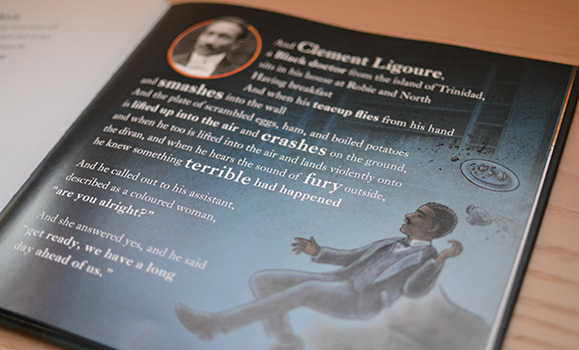The Halifax Explosion looms large in the history of Nova Scotia’s largest city. So large, that more than a century after the blast obliterated huge swaths of the city, people still find ways to mark its anniversary each year on Dec. 6.
Yet, for all this retrospection, a new book-length poem from Īꔄtv Professor Dr. Afua Cooper questions just how well we've done in remembering the whole story.
The Halifax Explosion: 6 December 1917, At 9:05 In the Morning, by Plumleaf Press, paints a powerful picture of an often overlooked aspect of the explosion: how the city's African Nova Scotian residents fared in the disaster and its aftermath.
Dr. Cooper’s research into the explosion began a few years ago when she was asked to deliver a poem at a commemorative anniversary event in 2019.
‚ÄúI chose to write about the explosion because I realized that the Black experience of the explosion was either denied or marginalized,‚ÄĚ says Dr. Cooper, who was Halifax's seventh poet laureate at the time. ‚ÄúAfricville, which was very close to the Narrows, was impacted.‚ÄĚ
A new take on a familiar story
Őż
The broad strokes of this historic event are by now well known, but Dr. Cooper's voice ‚ÄĒ as well as evocative illustrations from Rebecca Bender, compelling archival imagery, and thoughtful formatting ‚ÄĒ lend new poignancy to a familiar story.
The supply ship Imo, one of the two massive war-time ships to collide in a section of the Halifax Harbour called the Narrows that day at 8:45 a.m., finds character in Dr. Cooper's telling as a source of "life" off to "feed hungry soldiers"‚ÄĒ words bolded in larger font in the text. The Mont-Blanc munitions ship headed for the First World War in Europe, by contrast, was loaded with "death."
Death arrived early as munitions aboard the latter ship heated after the collision and exploded at 9:05 a.m., leaving thousands of people in the north end of the city ‚ÄĒ including Africville ‚ÄĒ dead, wounded, and homeless.
'The sick, needy and dying'
As Dr. Cooper conveys, African Nova Scotians were to face further suffering in the days ahead.
She writes of individuals whose pleas for help from the city were denied because of their race. Those like Mrs. Rose Hickey, who lost her husband, house and all her livestock in the explosion. Her three children survived, but her faith in the city’s officials did not, as Dr. Cooper’s verse makes clear:
She asked for help from the Disaster Relief Commission
But Old Jim Crow raised his nasty head
This, despite the heroic efforts and selfless actions of others in the African Nova Scotian community to help others pick up the pieces from the blast. One Clement Ligoure, a Black doctor from Trinidad, for instance. Dr. Ligoure stepped up to run a private hospital ‚ÄĒ he was denied privileges in the city‚Äôs hospitals ‚ÄĒand worked ‚Äúround the clock‚ÄĚ to treat the ‚Äúsick, the needy, and the dying‚ÄĚ for three days with hardly any food, drink or rest:
It is recorded that he treated close to 200 patients a day
And he did this for free
On day 4, he went to City Hall and demanded assistance . . .
Dr. Cooper’s vignette about Dr. Ligoure ends abruptly there, prompting the reader to linger on the perversity and injustice of the situation.

One of the book's spreads.
Elsewhere, we glimpse into the home of another African Nova Scotian family ‚ÄĒ this one likely more familiar to readers:
Viola Davis,
Later Desmond, only three years old
Is thrown from her high chair in her
Parents’ home, on Gottingen St.
She will live to overcome another struggle
Dispelling a myth
Maggie Goh, Plumleaf’s publisher, sent Dr. Cooper a brief message after hearing her deliver her poem during a broadcast of the ceremony in 2019.
"It is a book!" Dr. Cooper recalls her saying.
In addition to the poem, the 36-page book also includes a historical note along with a map showing the area of ‚Äútotal destruction.‚ÄĚ This addendum offers further insight into both the unfairness of how African Nova Scotians were treated after the disaster and the public‚Äôs lack of awareness about its impacts on Africville where many of them lived at the time.
‚ÄúThough Africville was not entirely destroyed, the community was ravaged, and many buildings were damaged,‚ÄĚ writes Dr. Cooper. ‚ÄúFor years after the blast, the myth that Africville had escaped the disaster was perpetuated, despite there being four recorded deaths. One death recorded was of an eight-year-old girl who died inside her house during the explosion.‚ÄĚ
Dr. Cooper will read from her book Tuesday, Dec. 5 ‚ÄĒ the eve of the explosion's anniversary ‚ÄĒ at the Halifax Central Library. .

